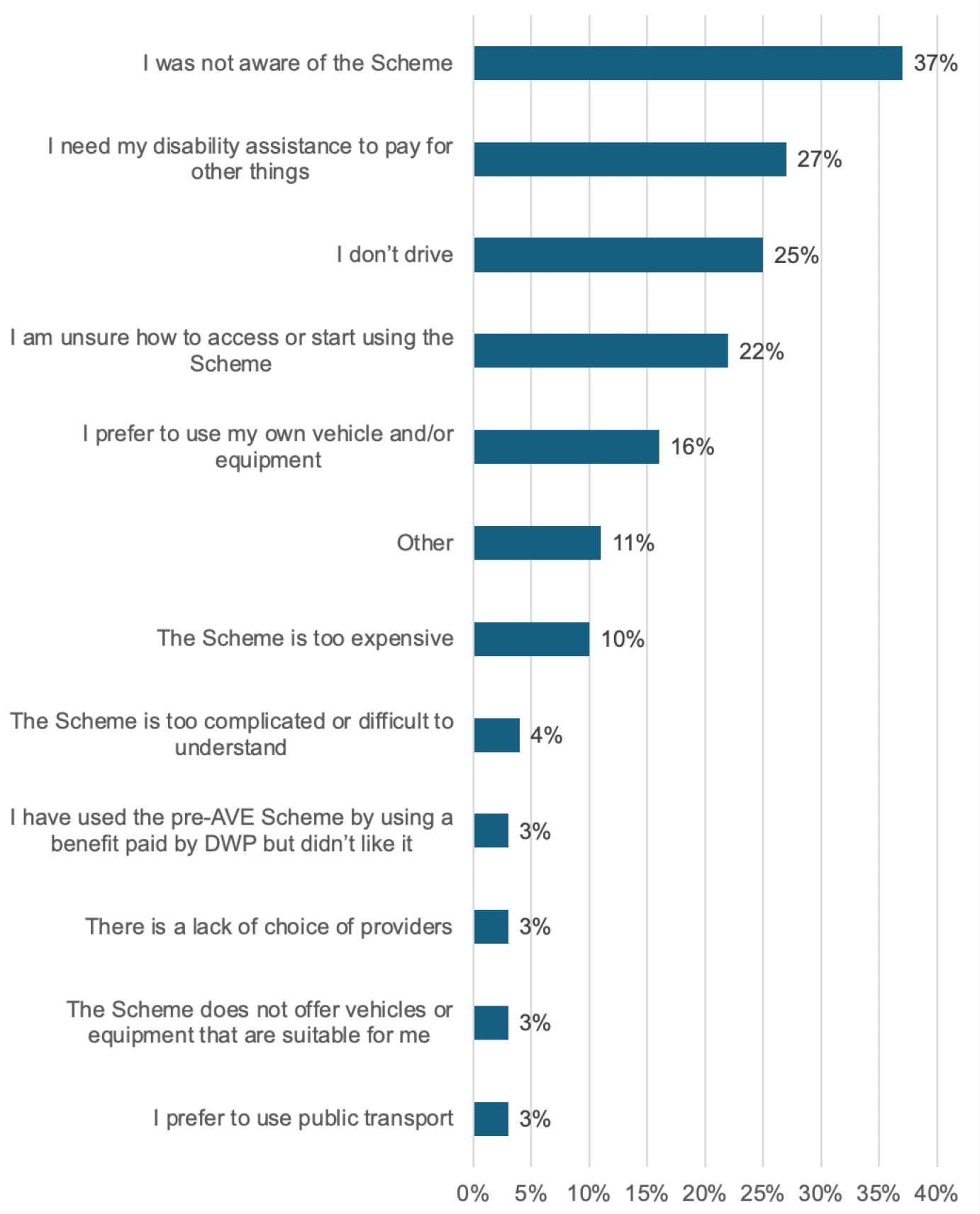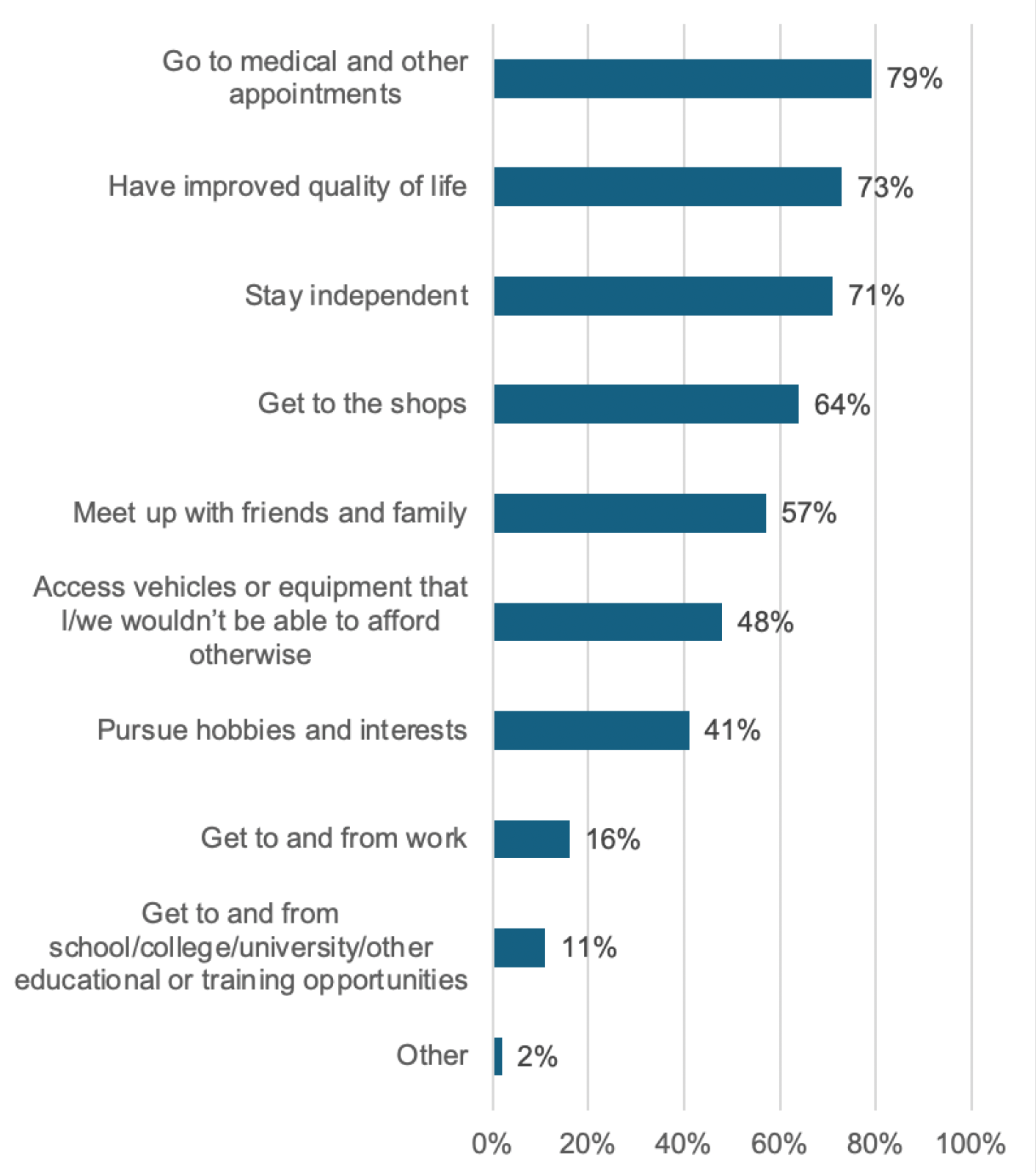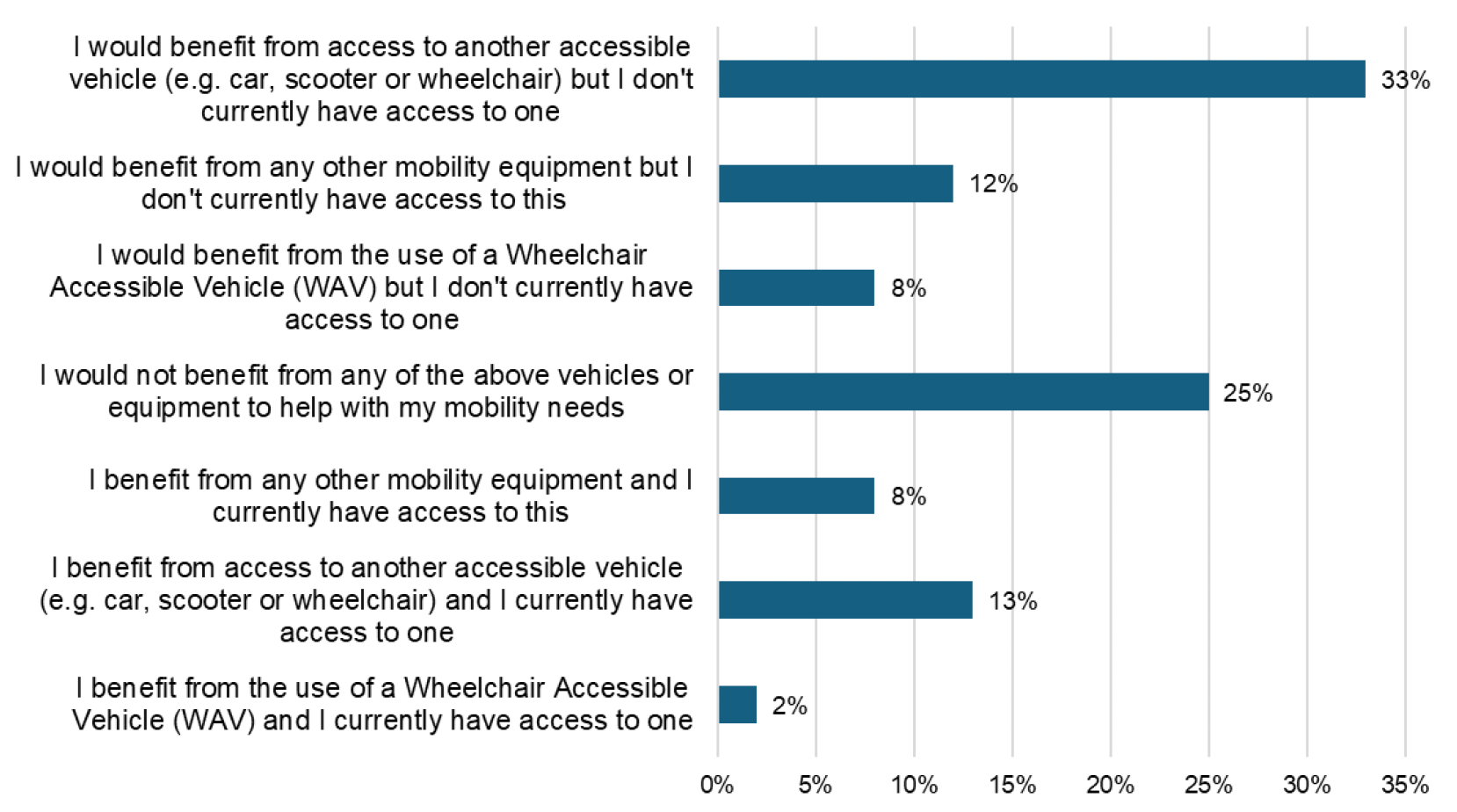Accessible Vehicles and Equipment Scheme evaluation - devolved disability benefits: research
We commissioned The Lines Between (TLB) to carry out research in May 2023 to inform a policy impact evaluation of the Accessible Vehicles and Equipment (AVE) Scheme. This report outlines the findings
7. Reasons for not using the Scheme
Introduction
This chapter considers non-members’ reasons for not using the Scheme, along with their views of what could be done to encourage or enable them to use the Scheme.
Reasons for not using the Scheme

Lack of awareness of the Scheme
The most common reason for not using the Scheme among the non-members who responded to our online survey was a lack of awareness (206, 37%), as shown in Figure 7.1. However, as discussed in Chapter 4, it is likely that awareness is greater than this data suggests. In follow-up interviews with non-members it became clear that some who had written in their survey response that they were not familiar with the AVE Scheme were in fact aware they could lease a vehicle through Motability; they just did not know this was now known as the AVE Scheme in Scotland. There were others, however, who were unaware they could use their disability assistance to lease a vehicle or equipment, as discussed in Chapter 4.
Need disability assistance to pay for other things
The second most common reason for not using the Scheme among survey respondents was a need to use their CDP or ADP assistance to pay for other things (150, 27%). These respondents said they needed all their payments to cover bills and living expenses, and this is consistent with the research referred to in Chapter 1 that the Scottish Government undertook with Social Security Scotland Experience Panel members in 2022.
“I would love a mobility car as I struggle to use my own. However, I would lose too much of my payments per month which I need to pay my bills and things.” (Non-member)
“I’ve waited so long to receive any money since I lost my job that I have other things I really need to buy first before I’d even consider spending all my ADP on a new car.” (Non-member)
“It's a fantastic scheme but it's unfortunately too expensive for me. I am even having to sell my current car as having any monthly payment larger than £100 means I have to skip more meals.” (Non-member)
As mentioned in Chapter 4, there were a few ADP and CDP clients who thought that all of their disability assistance (not just the mobility component) was required to access the Scheme.
The Scheme is too expensive
Similarly, 10% (57), described the Scheme as too expensive.
“I require a vehicle that would accommodate a wheelchair, dog and passengers. There is not a vehicle available on the Scheme that I can afford.” (Non-member)
Some respondents expressed concerns about the advance payments required for certain vehicles or equipment.
“I need a WAV car but cannot afford the high deposit so I bought a second hand one.” (Non-member)
“Anything that I would consider to be a usable size required either a hefty deposit or it uses up all of your Adult Disability Payment.” (Non-member)
Inability to drive or disqualification from driving
A quarter of survey respondents (141, 25%) identified an inability to drive as a reason for not using the AVE Scheme. This issue was more pronounced among respondents in less affluent areas: 34% (40) of respondents living in areas classified in SIMD quintile 1 reported not driving, compared with 18% (6) in the most affluent quintile. It was also more likely to be a barrier among respondents in urban areas (86, 30%) than rural (7,11%); and among ADP clients (135, 26%) than CDP (6, 14%).
Many survey respondents explained they are unable to drive because of their condition, either because they are disqualified from driving by the DVLA on medical grounds, or because they feel uncomfortable or reluctant to drive due to their health, even if they are not disqualified.
“I had to return my licence to DVLA due to health issues.” (Non-member)
“I am in a situation where the severe pain I suffer from puts me off even thinking about driving at this point in time.” (Non-member)
Another theme was non-members who are housebound or who cannot travel far and would not be able to use a vehicle or mobility equipment.
“I am housebound; therefore a car is pointless.” (Non-member)
“Right now I'm just too poorly to get the use out of it unfortunately.” (Non-member)
Conversely, a few interviewees explained that they might use the AVE Scheme if their condition deteriorates to a point where they need an adapted car. This includes ADP clients whose mobility could get worse and CDP clients who explained that their needs might change as their child gets older, particularly if it is necessary to lift them in and out of the car or to carry bulky equipment such as wheelchairs. As noted in Chapter 4, a few thought the Scheme only provided adapted vehicles.
“It would only be if my physical condition declined to a point where I did need specialist adaptations to a vehicle that I might consider maybe getting adaptations to my own vehicle or getting a specially crafted vehicle through the AVE Scheme.” (Non-member)
“The next [type of] wheelchairs to meet [my son’s] needs don't collapse. So right now he is in a buggy that can recline and have head supports and everything. So we have to have that because the wheelchair that has that level of support doesn't fold, it isn't collapsible. So we wouldn't be able to have that in our car. As soon as we can get rid of this car, our next car will be an accessible vehicle.” (Non-member)
Some said they do not drive because a friend or family member drives them to places.
“My daughter generally takes me to where I need to be so I use some of the money to pay for the diesel and to help towards her insurance.” (Non-member)
A small number reported a misconception that the vehicle can only be driven by the disabled person, rather than their family members or friends, as referred to in Chapter 4.
Uncertainty about how to access or start using the Scheme
Just over a fifth (124, 22%) of survey respondents said they were unsure how to access or start using the Scheme. Free text comments indicate this is due to a lack of awareness of the Scheme, as discussed in Chapter 4, or a lack of information about it.
“Still no information on how to access it at all.” (Non-member)
A few highlighted that, where they have received information, it could have been made clearer and easier to understand.
“The information that I originally received seemed complex and I didn’t get round to studying it because my concentration was not good at the time.” (Non-member)
“I would like clear instructions on how to join. I would like clear information on costings.” (Non-member)
This indicates that some clients find communication about the Scheme too complicated or difficult to understand; 4% of survey respondents (23) reported this as a reason for not using the Scheme.
Preference to use their own vehicle, equipment or public transport
Sixteen per cent (89) of survey respondents prefer to use their own vehicle or equipment. Some explained they use their CDP or ADP entitlement to contribute to fuel and maintenance costs for their own car, rather than leasing a vehicle or equipment through the Scheme. A few noted that their own car is more cost-effective than the AVE Scheme.
“The current payments associated with my car are less than the amount that would be taken off my ADP so it is cheaper to keep my current vehicle.” (Non-member)
“I live with my mum and she uses her own car. It is fully paid up and she doesn’t want more expensive outlays.” (Non-member)
A small number felt that accessing a vehicle or equipment outwith the Scheme offers more choice and flexibility.
“I do not use the AVE Scheme just now as it lets me choose a car more suitable for my requirements… it also gives me the option to upgrade and downgrade more easily if required to fit my needs.” (Non-member)
A preference for owning, rather than leasing, their vehicle or equipment was expressed by a few respondents.
“Another reason I don't go with Motability is I'm really not interested in leasing things, I'd rather something were actually mine.” (Non-member)
A small proportion of survey respondents (17, 3%) said they would rather use public transport, while others commented on the value of being able to use public transport or taxis alongside their own car.
“I like the mix of using my own car, taxi, train, bus, as the situation requires. If I used my mobility component for just a car I would not have the finances to afford public transport and petrol for a car.” (Non-member)
“I like to use public transport as I have my bus and railcard as I am over 65 years old.” (Non-member)
Lack of choice of vehicles and equipment and providers
Lack of choice of vehicles and equipment suitable to their needs was a barrier for a small percentage of respondents (19, 3%). A similarly small proportion of survey respondents (15, 3%) also identified a lack of choice of providers as an issue.
These non-members explained they could not find a vehicle or equipment suitable to their needs through the AVE Scheme. A couple, for example, said they need a larger car; one wanted to lease an e-bike, and another called for a larger range of wheelchairs.
“The vehicle options currently available on the Scheme are too limited and do not meet my needs. The cars are either too small to carry wheelchairs in the boot (hoist required) or are not suitable for family use once a wheelchair is in the boot. A full WAV would not be suitable as the ones available all have lowered/ramped floors as they assume the wheelchair user needs the ramp which makes the rear space impractical for family life. Some vehicles on the WAV section of the Scheme would be ideal but without the full WAV conversion or with minor custom conversions to maintain practicality.” (Non-member)
Previous negative experience of the pre-AVE Scheme
A small percentage (16, 3%) identified previous negative experiences of the pre-AVE Scheme as a reason for not using the AVE Scheme. Of these 16 respondents, 14 gave details of their experience. The main issue was costs – five of the 14 (36%) said the Scheme was too expensive. Three (21%) said there were not enough providers to choose from and the same number felt they were not treated with dignity or respect by the provider or dealer. For example, one interviewee would have valued their dealer offering to collect the car when it was being serviced.
Other reasons
Other reasons for not using the Scheme include:
- A concern that the vehicle or equipment might be taken away from them if their benefits entitlement changes before the lease ends.
- Individuals who are ineligible for the Scheme because there is less than 12 months before their CDP or ADP is due for review.
- Having purchased a vehicle or equipment before becoming eligible for or learning about the AVE Scheme.
Interest in the Scheme among non-members
Over half of survey respondents (302, 52%) indicated they would be interested in using the Scheme in the future, 40% (234) were unsure while only 7% (43) said they would not be interested.
Those who would be interested identified several perceived benefits of the Scheme, most notably help with accessing medical and other appointments (79%, 237), enhancing their quality of life (73%, 219) and maintaining their independence (71%, 213), as illustrated in Figure 7.2.

“If it's my own transport, then… it gives me a more independent way of getting about.” (Non-member)
“It would give you freedom, even if it was just to go around the park… I could go on holiday.” (Non-member)
Non-members also recognised the value of the Scheme in providing peace of mind regarding the vehicle and equipment’s maintenance.
“If anything is wrong with the car, the tyres and everything else is all being paid through Motability.” (Non-member)
“It would take away a lot of the headache of the maintenance of the vehicle.” (Non-member)
In addition, non-member survey responses underline the need for the Scheme. Just under a quarter (22%, 113) reported they already have a WAV, accessible vehicle or other mobility equipment, but over half (53%, 271) of those who answered this question noted they would benefit from a WAV, accessible vehicle or other mobility equipment, but do not currently have acces to this. A quarter (25%, 126) said they would not benefit from a WAV, accessible vehicle or other mobility equipment (Figure 7.3).

Encouraging and enabling use of the Scheme
Survey respondents and interviewees suggested various steps that could encourage or enable them to use the Scheme.
Enhance awareness
The most common suggestion for encouraging and enabling clients to use the Scheme was to raise awareness among eligible people who may be unaware or lack understanding of what the Scheme offers or how to access it. This issue is highlighted in Chapter 4.
Affordability
Another prevalent theme was a need to make the Scheme more affordable. Respondents suggested offering more affordable options with lower weekly payments as well as reducing the advanced payments required.
“Having more options that don't take the full whack of your mobility portion, or don't need a large sum of money to do a down payment, because I don't have any spare money.” (Non-member)
A few suggested that the Scheme could be more affordable if it could be used to access used cars.
“Not all cars have to be brand new. It could work just as well with preloved vehicles (and equipment).” (Non-member)
Wider range of vehicles and equipment
Many respondents suggested that offering a wider range of vehicles and equipment could encourage them to use the Scheme.
“If they offered a bigger or a wider variation on the cars that they can offer, that would be helpful, because, in my opinion, there seems to be a shortage of when you go from a normal type car to an SUV, to a WAV… There doesn't seem to be bigger vehicles before you get to the WAVs.” (Non-member)
“Perhaps if there were more options. Smaller cars, automatic.” (Non-member)
“If you offered e-bikes I would join straightaway.” (Non-member)
Help with driving lessons
Some suggested providing funding to help people learn to drive to encourage more people to use the Scheme. The Motability Foundation offers support to access driving lessons.
“Provide complimentary driving lessons and tests to be able to access a car.” (Non-member)
Fear of losing award and vehicle
Allowing longer periods of time between reviews of CDP and ADP entitlements was suggested by some respondents. This would help clients feel more confident their benefits entitlement will not change and their vehicle or equipment will not be removed.
“If people with a lifelong condition/disability that will never improve are given longer between reviews I may consider using the Scheme but at present three-yearly reviews make this totally untenable for those with physical disabilities who rely on their car for independent travel as well as to travel for work, who cannot afford to rely on the whim of a third party resulting in being unable to get to work or social activities because they are no longer eligible to use the Scheme at very little notice. I would find the anxiety around this too great and so I prefer to use my own car that no-one can take away.” (Non-member)
Geographical proximity of dealers
Accessing dealers more locally could encourage some respondents to use the Scheme, particularly in rural areas.
“I live on one of the Scottish Isles and there’s no local dealership. Offering offshore deliveries would enable me to use the Scheme.” (nm survey 370)
Chapter summary
The main reason why non-members had not used the Scheme was a lack of awareness of it. This issue, and suggestions for enhancing awareness were considered in Chapter 4.
Other reasons focus on the expense of the Scheme, including the weekly payments that are taken from an individual’s CDP or ADP assistance to pay for the Scheme, and the advance payments required for certain vehicles or equipment. Respondents explained they need their CDP or ADP assistance to pay for other things, particularly while the cost of living is high. Some expressed a preference to use their own vehicle or public transport and, less commonly, participants raised issues around a lack of suitable vehicles or equipment and the Scheme’s complexity.
However, just over half of survey respondents would be interested in using the Scheme in the future (52%) while a large proportion (40%) were unsure. Non-members recognised the potential benefits of the Scheme, most commonly in helping to attend medical and other appointments, improving their quality of life and improving or maintaining their independence.
Non-members reflected on what could be done to encourage or enable them to use the Scheme, with the most common reasons being improving awareness and enhancing the affordability of the Scheme as well as, less commonly, providing a more comprehensive range of vehicles and equipment.
Contact
Email: socialresearch@gov.scot
There is a problem
Thanks for your feedback